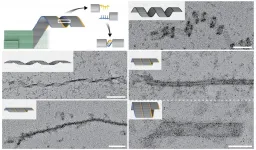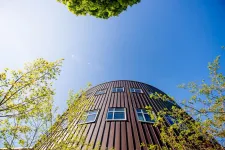The AI-powered platform combines machine learning and a specially-designed microfluidic chip with analysis of 2D video images of blood flow and the application of physical laws, to infer how blood flows in 3D. In tests, it accurately predicted blood flow characteristics such as speed, pressure, and shear stress, which is the stress exerted by the blood flow on the vessel wall.
The ability to determine these characteristics accurately could be a critical support for clinicians in detecting and tracking the progression of vascular diseases since the abnormalities that the platform could spot (such as an abrupt change in speed or shear stress of blood flow) may indicate the presence or progression of a vascular disease.
The platform and its proof-of-concept findings from the research team led by NTU President and Distinguished University Professor Subra Suresh, Brown Professor George Em Karniadakis, and MIT Principal Research Scientist and NTU Visiting Professor Ming Dao are reported in the Proceedings of the National Academy of Sciences of the United States of America on 22 March.
To validate the platform, the scientists tested it on simulated microaneurysms of the eye, using a microfluidic chip that is smaller than a thumbnail. Microaneurysms are bulges in the micro-scale blood vessels of a diabetic patient's eye, and are the earliest signs of diabetic retinopathy, the leading global cause of vision loss and blindless in diabetic working adults.
When the AI platform was given images of blood flow in a device that simulates microaneurysms, it successfully predicted the characteristics of blood circulation within it.
The AI platform and the microaneurysm-on-a-chip could one day help medical practitioners with monitoring vascular disease progression in humans and may be particularly useful for diseases of the body's smallest blood vessels.
Prof Subra Suresh, the study's senior author, said: "Currently, measuring the mechanics of blood flow in the smallest blood vessels requires sophisticated equipment and trained personnel. Our AI technology integrates images, experimental data, and the underlying physics, enabling microcirculation blood flow to be analysed easily and accurately to assess vascular injury and disease state. With this platform, we can now gain important mechanical information and insights into disease evolution mechanisms that were previously very cumbersome to extract."
While the platform was developed for microaneurysm monitoring, it could be adapted to monitor other diseases of impaired blood vessels, said the scientists.
Prof George Karniadakis, the study's co-corresponding author and professor of Engineering and Applied Mathematics at Brown University, said: "We tested our platform on microaneurysms, the earliest symptom of diabetic retinopathy, which is the leading cause of vision loss in working-age diabetic patients globally. Our ultimate goal is to use the platform in clinical settings for diabetic retinopathy diagnosis and prognosis as well as in other diseases involving impaired blood flow."
The team hopes to test their platform on clinical imaging data of microaneurysms in order to correlate the blood flow characteristics of microaneurysms to factors such as disease severity and potential risks.
The challenge of monitoring blood vessel disease progression
Despite rapid advances in imaging techniques such as retinal photography analysis and optical coherence tomography, it is not feasible to observe biological processes in microcirculation in real time, such as the rupture of a microaneurysm in the eye's blood vessels and the development of blood clots.
As a result, to learn more about how these diseases progress, scientists have been using traditional microfluidic devices - devices that shuttle around miniscule amounts of fluids in tiny channels carved into a microchip - to mimic the physiological conditions of a vascular disease. These existing methods, which either rely on visual image analysis, or the application of the physical laws underlying blood flow, do not provide an accurate assessment of blood flow characteristics, particularly in vessels with complex geometries, such as a microaneurysm in the eye.
The research team demonstrated the AI platform's capabilities on a microaneurysm-on-a-chip, a microfluidic device that the team designed to mimic blood flow in round microaneurysms, the most common type found in diabetic patients .
A 20-microlitre blood sample - about half a drop of blood - was loaded onto the chip, and a high-speed camera was used to capture images of blood moving through the microchannels.
The scientists found that their AI platform predicted the characteristics of blood flow such as speed, pressure, and stress exerted by the blood flow on the vessel wall in small, intermediate, and large microaneurysms more accurately and efficiently than existing computational methods.
The team believes their technology may become a powerful tool in the diagnosis and monitoring of microaneurysms using images taken from actual microaneurysms. It could also potentially be combined with microfluidic devices that simulate other types of disorders involving impaired blood vessels to predict blood flow characteristics and monitor other vascular diseases.
INFORMATION:
Other authors involved in the study are NTU research fellow Dr Kong Fang, former visiting NTU research fellow and MIT postdoc Dr Fuyin Zheng, and Dr Shengze Cai and Assistant Professor He Li from Brown University.
Dr Cai, Asst Prof Li, Prof Dao, Prof Karniadakis, and Prof Suresh have filed a patent for the AI platform.
Note to Editors:
Paper 'Artificial intelligence velocimetry and microaneurysm-on-a-chip for three-dimensional analysis of blood flow in physiology and disease' published in PNAS. 2021 Vol. 118
DOI: 10.1073/pnas.2100697118
***END***
Media contact:
Foo Jie Ying
Manager, Corporate Communications Office
Nanyang Technological University
Email: jieying@ntu.edu.sg
About Nanyang Technological University, Singapore
A research-intensive public university, Nanyang Technological University, Singapore (NTU Singapore) has 33,000 undergraduate and postgraduate students in the Engineering, Business, Science, Humanities, Arts, & Social Sciences, and Graduate colleges. It also has a medical school, the Lee Kong Chian School of Medicine, established jointly with Imperial College London.
NTU is also home to world-class autonomous institutes - the National Institute of Education, S Rajaratnam School of International Studies, Earth Observatory of Singapore, and Singapore Centre for Environmental Life Sciences Engineering - and various leading research centres such as the Nanyang Environment & Water Research Institute (NEWRI) and Energy Research Institute @ NTU (ERI@N).
Ranked amongst the world's top universities by QS, NTU has also been named the world's top young university for the past seven years. The University's main campus is frequently listed among the Top 15 most beautiful university campuses in the world and has 57 Green Mark-certified (equivalent to LEED-certified) buildings, of which 95% are certified Green Mark Platinum. Apart from its main campus, NTU also has a campus in Novena, Singapore's healthcare district.
Under the NTU Smart Campus vision, the University harnesses the power of digital technology and tech-enabled solutions to support better learning and living experiences, the discovery of new knowledge, and the sustainability of resources.
For more information, visit http://www.ntu.edu.sg.




